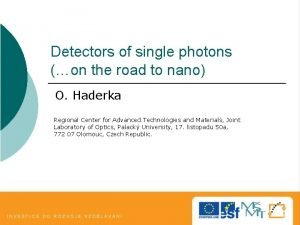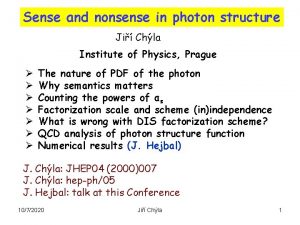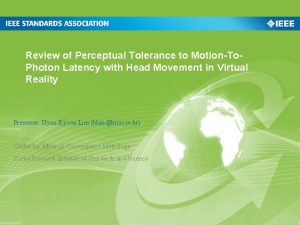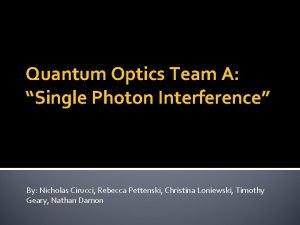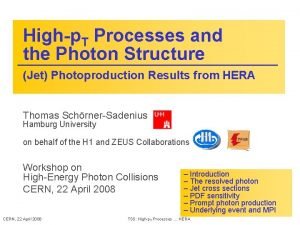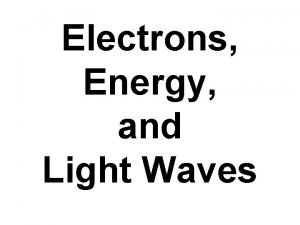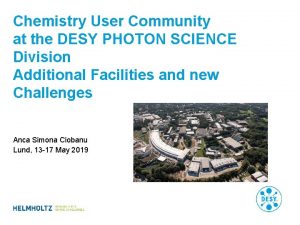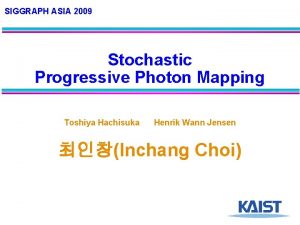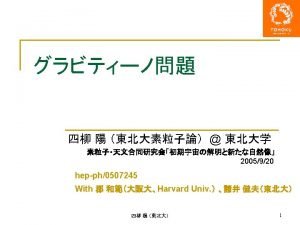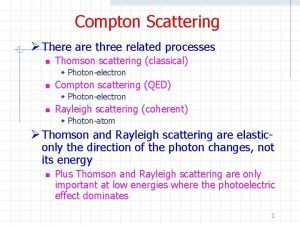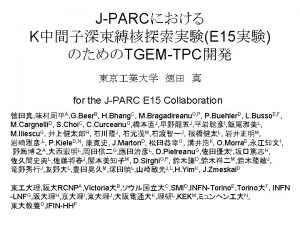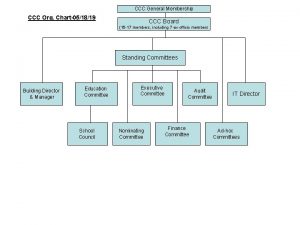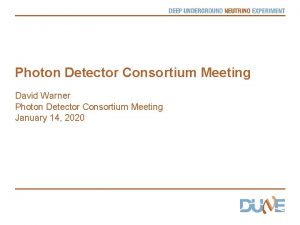TCPD TGEM CCC Photon Detector test measurement ELTE













- Slides: 13

TCPD (TGEM CCC Photon Detector) test measurement ELTE, MTA KFKI RMKI, REGARD Group (Budapest, Hungary): Levente Kovács G. Hamar, M. Mátyás D. Varga Zimányi Winter School 2011, Budapest TCPD test measurement 1

Contents • • • Chamber structure - motvation Measurements with beta source Ion and electron dirft in the chamber Measurements with UV LED Single photoelectron (PE) charge distribution Photoelectrons & gain vs high voltage (TGEM, SW) • Summary TCPD test measurement 2

Chamber structure - motivation • Optimal matching of two amplifier stages (TGEM- Thick Gas Electron Multiplier and CCCClose Cathode Chamber). • TGEM acts as electron pre-amplifier (gain 10100). • CCC (MWPC- Multi Wire Proportional Chamber) works as further amplifier (gain 100010 000). • Ion currents reflect field configuration. • Principle aim: to detect a single photoelectron with the TCPD chamber! TCPD test measurement 3

Main sections of the chamber (chamber structure) Three sections : • Between cathode and TGEM: drift region. • TGEM (preamplifier). • Between bottom of the TGEM and the wire plane: extraction region. • Readout TCPD test measurement 4

Electrostatic field in the TGEMCCC & Chamber design TCPD test measurement 5

Ion and electron drift in the chamber (whit beta & UV LED sorce) • Avalanches are induced by single electrons (from ionization or PE) (UV LED). • Continuous current is observable from ions drifting upwards (Beta). • Typical voltage setting charges • Ions potentially cause ageing on the TGEM surface. TCPD test measurement 6

Ion currents as function of the extraction field • Beta source used for irradiation. • Low field: all currents go to the Field Wires (red line). • Higher field: currents to go the TGEM top (green), focusing effect. • Very high extraction field: currents go to the TGEM bottom (blue). • Cathode: always low currents (purple). TCPD test measurement 7

Single photoelectron charge distribution (UV LED pulses) • Avalanche statistics: single electron gives exponential total charge (very high fluctuation). • Exponential fit: area gives PE count, slope proportional to total amplification. • Often the Pólya distribution is used as approximation. • The total photoelectron per event is kept low (0. 1 – 0. 3 / event) to obtain the real single PE response. 8 TCPD test measurement

Single PE charge distribution vs. TGEM voltage • Shape of the curves are conformal. • Increasing TGEM voltage increases efficiency (not only signal / noise ratio). • Departure from exponential becomes prominent at low charges. • (fix TGEM =1100 Volts) TCPD test measurement 9

Total amplification gain vs. TGEM and CCC voltages • Upper panel: Gain vs. TGEM voltage. • Lower panel: Gain vs. CCC sense wire voltage. • Gain is exponential as a fuction of both variables, reflecting that the gain can be balanced between the two stages. • No difference between UV LED and Beta source measurements: no saturation in the high gain (single electron sensitive) mode. TCPD test measurement 10

Photoelectron yield vs TGEM and CCC voltages • Expectation: the PE number does not change with the sense wire voltages (but the gain does!) • Photoelectron count development as a function of TGEM voltage (lower figure) • The PE count after an initial exponential increase saturates at TGEM=1000 volts. • Finding (measured data): There is some shallow dependence on TGEM voltage, due to improving PE extraction from TGEM surface. • No dependence within error margines on CCC sense wire voltage. TCPD test measurement 11

Summary • Single photoelectron detection possibility demonstrated with high signal / noise ratio. • Two stage amplification (TGEM and CCC): increased stability and gain control. • Ion back flow follows expected trends, gives information on internal electrical field. • We have detected single photoelectrons with the first TCPD chamber. • Applicability in different gas compositions (measurements with different gas mixtures see M. Matyas’ talk). TCPD test measurement 12

Thank you for your attention! TCPD test measurement
